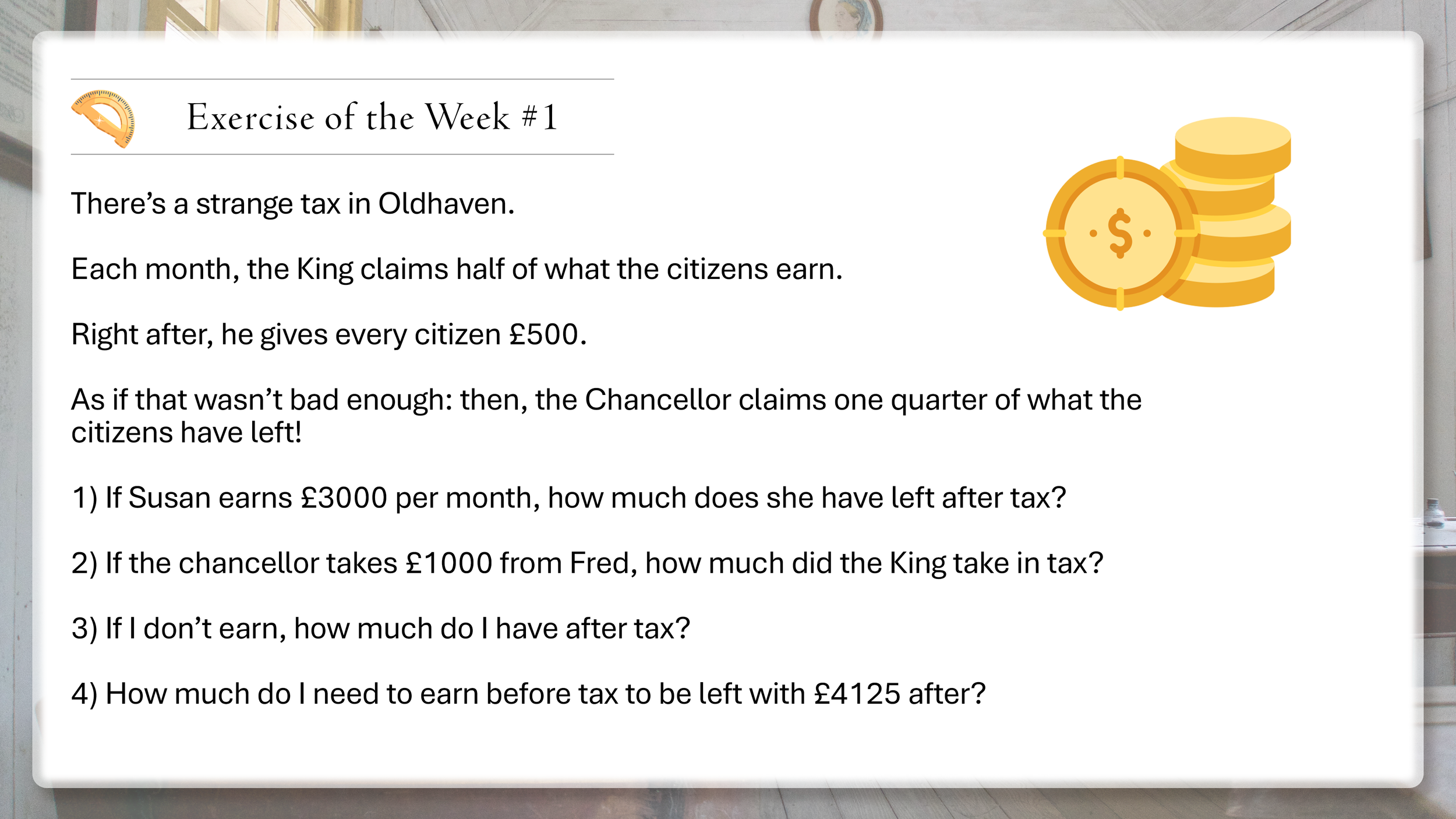
Exercise of the Week #13
A little maths exercise worthy of the heatwave.
Last Week’s Answers
In this sequence question, we mustn’t rule anything out as a red herring or distractor: part of the pattern that is only included to draw your attention from what’s actually happening.
In this puzzle, everything is important!
Between each pattern, we can see that the star is changing. If there is a shape which appears throughout the sequence, look to see whether it is rotating, reflecting, growing/shrinking or changing. In this sequence, the star is gaining a point each time.
The spiral is also consistent - as above, we need to think about how. In this sequence, the spiral is flipping each time.
There’s also something going on with these dots. It’s not enough to say that there’s one extra dot; that’s too surface level. Instead, notice that the new dot remains, and each time, another dot is added. Another way to think about this is that the black dot moves and is replaced by a grey dot each time.
Three things to spot! How many did you find?
Exercise of the Week #10
Maths! Pirates! Avast!
Last Week’s Answers
To solve coded word problems such as this, you need to look for shared letters and letter groups within the words.
Two of our words start with an ‘H’, and two of our numbers start with a ‘1’, which tells us that H = 1.
One of our H words ends with S, and one of our other words begins with an S. We need to find a number that does the same thing – starts with a digit that one of the other numbers ends with.
So, take a look at the numbers which start with 1: one of them ends with a 5, but none of the other letter codes start with a 5. One of them ends with a 6, and another letter code starts with a 6.
This tells us that S = 6.
We can now see that SCOUR = 67342, as it is the only word starting with an S.
Let’s review what we now know.
1 = H2 = R3 = O4 = U5 = ?6 = S7 = C8 = ?9 = ?We have a few letters in 13485: HOU??
The only word which matches this opening is HOUND. Which tells us that 8 = N and 5 = D.
We can work out our final letter by looking at 14896: HUNTS. This tells us that 9 = T.
We now know all the letters and the questions are easy to solve.
1 = H2 = R3 = O4 = U5 = D6 = S7 = C8 = N9 = TSCOUR = 67342
CRUSH = 72461
STUNTS = 694896
13961396 = HOTSHOTS
CONSTRUCTORS = 738692479326
Kudos if you found the last one without mistake.
Exercise of the Week #4
Back to mathematics this week, as we look at a viral problem you might’ve encountered before.
Last Week’s Answers
Agnetha says she is a liar. It’s a bit of a paradox, but if you’re a liar, you can’t admit to it, because then you’d be telling the truth. Likewise, you can’t be a truth-teller and call yourself a liar.
However, Agnetha actually says: ‘Brillon and I are also liars’. This statement can be a lie if Brillon is a truth-teller.
As we know Brillon is a truth-teller, what Charlton says is true, making him a truth-teller too!
So:
Agnetha is a liar, and the others are both truth-tellers.
Exercise of the Week #3
This week we’ll be looking at a logic puzzle. These can appear in verbal reasoning or critical thinking examinations, requiring students to analyse each statement and consider whether an assumption can hold true for the rest of it. Let’s take a peek:
Last Week’s Answers
Here are a few quick techniques you can employ to write persuasively:
Lists of three: Humans are quite attached to the number three. Using lists of three allows you to pack in more information, to be more memorable, and to be more persuasive. (See?)
Emotive language: Pull on the heart strings! If you’re writing to persuade someone to donate to a dog’s shelter, describe those poor, lonely puppies, who cry for a good home!
Rhetorical questions: Haven’t you heard of them? These are questions which don’t require an answer. Would you like to live on the streets?
Here’s an example paragraph arguing against the points given:
It’s not unusual to dislike homework. Many students consider it to be a burden, further constraining their already busy schedules so that they are unable to spend time doing the things they enjoy. However, homework that is well-thought-out by teachers needn’t take students hours to complete: in fact, studies have shown that most students spend no longer than an hour each evening on homework. That’s not too honorous, is it? It has been said that scrapping homework would provide teachers more time to prepare their lessons and mark other work. While this is true, it is the job of teachers to both set and mark homework (as well as planning lessons.) If marking homework is getting in the way of other responsibilities, teachers have not been considering the homework they are setting thoroughly. A well-considered task shouldn’t take forever to mark!Finally, there is an argument that homework does more harm than good. But, as the school day is limited, these extra weekly hours are vital to ensure topics covered in class are consolidated. Not everything can happen in the classroom. Well-considered homework prepares students to learn independently, engages them, and provides critical consolidation of work already covered. If it were banned, I am certain we would see grades fall and achievements dwindle. Would you want that for your child?Exercise of the Week #1
I’ve decided to launch exercise of the week!
Be sure to check back each week for a new mathematics, English or reasoning exercise.
The answers will be posted next time. Good luck!
Exercise of the Week
Archive
-
English
- Feb 25, 2023 Exercise of the Week #2
- Mar 18, 2023 Exercise of the Week #5
- Apr 30, 2023 Exercise of the Week #8
- May 21, 2023 Exercise of the Week #11
- Jun 25, 2023 Exercise of the Week #14
-
Math
- Feb 18, 2023 Exercise of the Week #1
- Mar 11, 2023 Exercise of the Week #4
- Apr 23, 2023 Exercise of the Week #7
- May 14, 2023 Exercise of the Week #10
- Jun 11, 2023 Exercise of the Week #13
-
Reasoning
- Mar 3, 2023 Exercise of the Week #3
- Mar 25, 2023 Exercise of the Week #6
- May 7, 2023 Exercise of the Week #9
- Jun 4, 2023 Exercise of the Week #12





